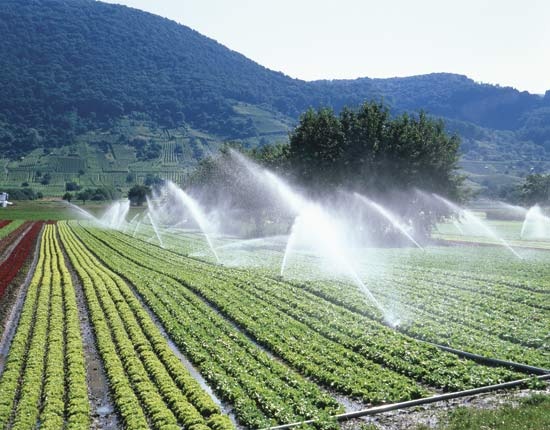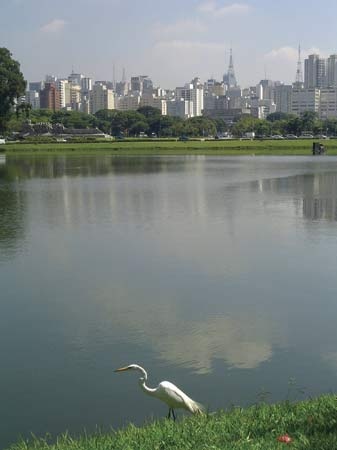water-supply system
 arrangement for transporting water from areas of abundance to an area of shortage. This includes works for the collection, transmission, treatment, storage, and distribution of water for homes, commercial establishments, industry, and irrigation, as well as for such public needs as fire fighting and street flushing.
arrangement for transporting water from areas of abundance to an area of shortage. This includes works for the collection, transmission, treatment, storage, and distribution of water for homes, commercial establishments, industry, and irrigation, as well as for such public needs as fire fighting and street flushing.A brief treatment of water-supply systems follows. For further discussion, see environmental works.
 There is much archaeological evidence to indicate that ancient peoples were concerned with their water supply. Wells were sufficient for small communities, and rivers provided enough water for civilizations along the Tigris and Euphrates, the Nile, and the Indus rivers; but as populations grew, wells had to be dug deeper, and water had to be brought in from more distant sources. These ancient systems included storage reservoirs at water sources, canals and aqueducts for water conveyance to points of use, and water-distribution systems. Highly advanced systems appeared about 2500 BC and reached their peak in the system supplying ancient Rome. The outstanding features of this system were the 11 aqueducts totalling 359 miles (578 kilometres) in length—of which 30 mi were supported on stone arches—that delivered some 50,000,000 gallons (189,000,000 litres) of water to the city daily. The water was distributed from large storage cisterns to public fountains and baths by an elaborate system of lead pipes.
There is much archaeological evidence to indicate that ancient peoples were concerned with their water supply. Wells were sufficient for small communities, and rivers provided enough water for civilizations along the Tigris and Euphrates, the Nile, and the Indus rivers; but as populations grew, wells had to be dug deeper, and water had to be brought in from more distant sources. These ancient systems included storage reservoirs at water sources, canals and aqueducts for water conveyance to points of use, and water-distribution systems. Highly advanced systems appeared about 2500 BC and reached their peak in the system supplying ancient Rome. The outstanding features of this system were the 11 aqueducts totalling 359 miles (578 kilometres) in length—of which 30 mi were supported on stone arches—that delivered some 50,000,000 gallons (189,000,000 litres) of water to the city daily. The water was distributed from large storage cisterns to public fountains and baths by an elaborate system of lead pipes.During the Middle Ages, water supplies were largely neglected, and epidemics caused by waterborne organisms were common. In the 17th and 18th centuries, distribution systems utilizing cast-iron pipes, aqueducts, and pumps were installed in London and Paris. During the 19th century the pollution of most water supplies became so serious that slow-sand filtration was initiated; and by the end of the century the realization that diseases could be transmitted by water led to the use of sterilizing chemicals, usually chlorine compounds.
 Water sources for modern supply systems include wells, rivers, lakes, and man-made reservoirs. When points of use are near sources, direct intake can be used. Offshore intakes are sometimes built in lakes to obtain water of better quality and to avoid freezing problems in winter. Reservoirs are formed usually by constructing dams near the collection point of mountain-water runoff or across rivers. Dams provide a way of regulating water collection and flow so that the supply remains constant.
Water sources for modern supply systems include wells, rivers, lakes, and man-made reservoirs. When points of use are near sources, direct intake can be used. Offshore intakes are sometimes built in lakes to obtain water of better quality and to avoid freezing problems in winter. Reservoirs are formed usually by constructing dams near the collection point of mountain-water runoff or across rivers. Dams provide a way of regulating water collection and flow so that the supply remains constant.Modern aqueducts—comprising canals, closed tunnels, and large pipelines—deliver water by means of gravity in some cases, but usually some method of pressurization is used. After the water reaches collection points it is normally given some kind of treatment to improve its quality to a usable level. Most important is the purification process, which destroys harmful bacteria and deactivates viruses. Liquid chlorine is the most common chemical used in modern treatment plants and is usually applied before other treatment and as a final treatment before distribution. In some plants, ozone and ultraviolet light are used as disinfectants.
Water-treatment works employ a variety of other treatment processes, which include long-period storage, aeration, coagulation, sedimentation, softening, and filtration; these processes are used in varying combinations, depending primarily on the characteristics of the water but also on its intended use. Long-period storage, usually in reservoirs or setting basins, gives particulates a chance to settle out, and filtration through beds of fine sand or through crushed anthracite coal can trap the suspended matter. Different chemical additives cause particles to coagulate and thus to settle. Aeration mixes air with water either by spraying the water into the air or by forcing small air bubbles through the water and is used primarily to reduce unpleasant odours and tastes. Softening is the process of removing calcium and magnesium from the water either by chemical precipitation or by ion exchange.
In parts of the world where there is little or no fresh water, plants that desalt seawater, wastewater, and highly mineralized groundwater have been constructed. The methods used to remove salt from water include distillation, in which salt water is evaporated and fresh water is condensed; crystallization, where salt water is frozen in such a way that salt-free ice is formed and then thawed; and a membrane process, where the membrane filters the salt ions from the water. The first large desalting plant was built in Kuwait in 1949. Subsequent technological advances have allowed for larger, more efficient plants to be built. The Ashqelon plant in southwestern Israel, which opened in 2005, has a daily capacity of more than 80,000,000 gallons.
After treatment, water is pumped either directly into the distribution system or to an elevated storage location, such as a water tank. For adequate distribution, water systems must operate under pressure. In some cases, the gravity drop of water from its elevated storage location provides enough pressure; otherwise, it is supplied by a pumping station. Adequate pressures range between 30 and 100 pounds per square inch (2 and 7 kilograms per square centimetre). Many communities base water-pressure requirements on what is thought to be adequate to fight fires, where pressures of up to 75 pounds per square inch are sometimes necessary. Materials used in transporting water to homes and industries include pipes of cast iron, steel, concrete, and asbestos cement. Meters record water usage at the site of consumption, and charges are levied to help pay for operation and maintenance of the system.
- Melbourne, William Lamb, 2nd Viscount, Lord Melbourne, Baron of Kilmore, Baron Melbourne of Melbourne
- Melchers, Gari
- Melchior de Hondecoeter
- Melchior, Graf von Gleichen und Hatzfeldt
- Melchior Hatzfeldt, Graf von Gleichen und
- Melchior Hofmann
- Melchior, Johann Peter
- Melchior Klesl
- Melchior Lussy
- Melchiorre Cesarotti
- Melchite
- Melchizedek
- Melchizedek priesthood
- Melchor Cano
- Meleager
- Melen, Ferit
- Meletios Pegas
- Meletius of Antioch, Saint
- Meletius of Lycopolis
- Melfi
- Mel Gibson
- Meliaceae
- melilite
- Melilla
- Melina Mercouri